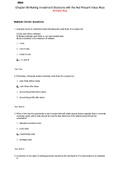Summary
Summary TUe (6A2X0) Introduction to Organic Chemistry and Chemical Technology Full Revision Notes (Chemistry Part) 15th June 2023
Lewis dot structures Dots are used to represent the electrons in the valence shell of atoms, and covalent bonding is indicated by pairs of electrons placed between atoms. Multiple bonds are represented with multiple pairs of electrons. Note that non-bonding lone pairs should be included.
[Show more]













